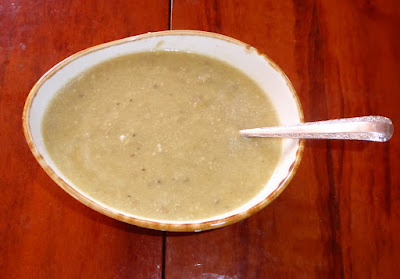I find it hard to get excited about courgettes. Baby ones, fried in good olive oil and garlic are delicious, but that’s largely because of the olive oil and the garlic. They sop up the flavours well. They are also good in ratatouille, especially with cannellini beans, for the same reason and indeed, can be used in all sorts of soups and stews; however when there’s a glut of them, it isn’t usually the time of year that you want to eat soup and stew. Now I realise, that to many people, curry is not only similar to a stew, but because of the chilli and warming spices, might seem even less appealing in hot weather, but I adore curry and can eat it any time and in any weather. so to me it is a perfect way of using a bounty of courgettes. I already have a recipe for courgette with chana dal, however this recipe is is quite different and more of a side dish than a main one, althoughI have some suggestions for using it as a main course. This is a pretty straightforward recipe and I think most people would be happy to tackle it, but because it uses non-standard ingredients, I'll call it a Curry for Cooks.
This recipe is based on one of Swasthi's recipes and I think it’s a great way to cook courgettes. The coconut milk makes it rich and substantial and all it needs is some rice to go with it, but of course a pan of dal would turn it into a generous meal. Alternatively, you can serve it with quinoa, whose protein will turn this into a fully-nutritious meal. I confess to finding quinoa worthy, but dull, particularly compared to brown basmati rice. However, if you're concerned about your protein intake, it's a good choice.
Even though this is made with Kashmiri chilli powder, rather than chilli flakes or cayenne, it packs quite a zing. If you don’t like too much heat in your curry, reduce the amount of chilli powder.
Serves 2 for a main course, 4 as a side dish
Ingredients
- Heat the oil in a saucepan and when it’s hot, add the mustard and cumin seeds
- When the mustard starts to sputter, add the green chilli and cook for 30 seconds.
- Add the chopped onions and ginger and cook for several minutes until the onions start to turn gold. If you are using salted lime, (or lemon) add this now.
- Lower the heat and add the garam masala, chilli powder, salt and turmeric.
- Now add the tomato and courgette and fry for a few minutes, stirring from time to time.
- Add the peas and the coconut milk and bring to the boil. Mix well and turn the heat low.
- Cook the courgette until its soft enough to suit your taste.
- Just before the curry is ready, add the fenugreek leaves and mix them in.
- Taste and add more salt or garam masala if required.
Serve with rice, quinoa or flatbread.
Notes:
- *Freeze-dried ‟Surprise” peas are very useful to have on a boat. Substitute with fresh or frozen if you have such a thing. Or perhaps 1/2 cup cooked dried, green peas, which would make this recipe much more substantial. Or maybe some diced carrot.
- If you don’t have a green chilli leave it out (try to buy pickled ones, if you think you'll be making a lot of curry).
- Substitute 1/4 tsp cayenne or chilli flakes for the Kashmiri chilli powder.
- Substitute 1/4 tsp fenugreek seeds if you don’t have the leaves; add them with the other spices.
- Use less coconut milk, or leave it out for a dryer curry.














